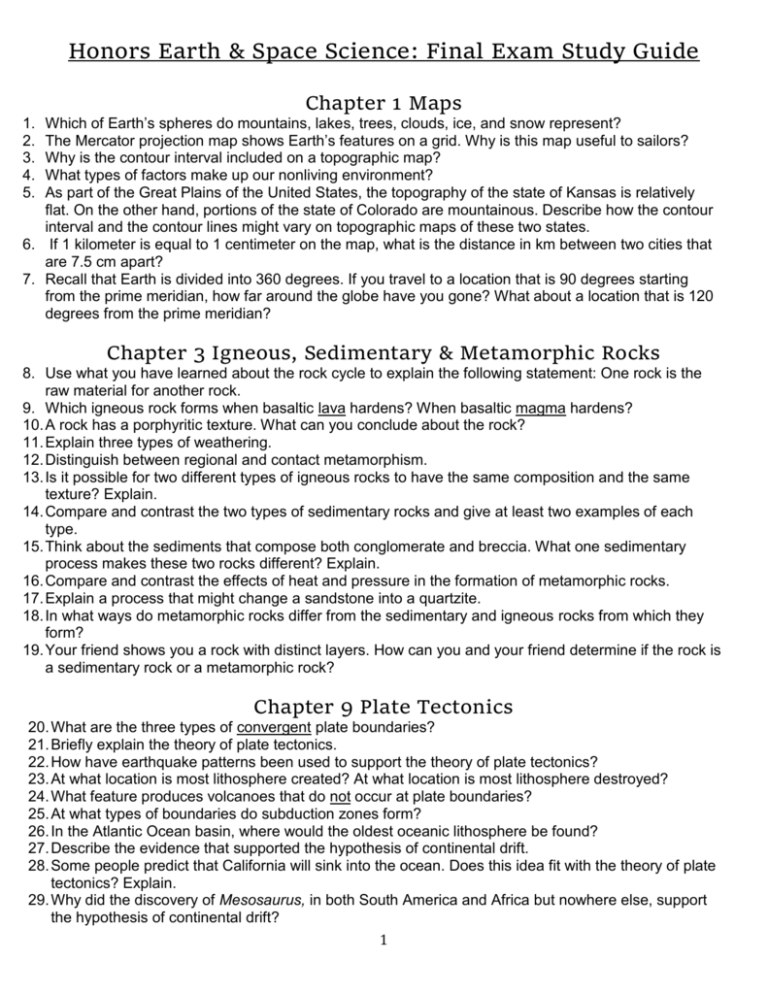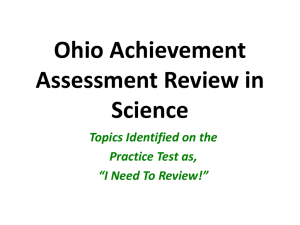Earth and Space Exam Study Guide
advertisement

Honors Earth & Space Science: Final Exam Study Guide Chapter 1 Maps Which of Earth’s spheres do mountains, lakes, trees, clouds, ice, and snow represent? The Mercator projection map shows Earth’s features on a grid. Why is this map useful to sailors? Why is the contour interval included on a topographic map? What types of factors make up our nonliving environment? As part of the Great Plains of the United States, the topography of the state of Kansas is relatively flat. On the other hand, portions of the state of Colorado are mountainous. Describe how the contour interval and the contour lines might vary on topographic maps of these two states. 6. If 1 kilometer is equal to 1 centimeter on the map, what is the distance in km between two cities that are 7.5 cm apart? 7. Recall that Earth is divided into 360 degrees. If you travel to a location that is 90 degrees starting from the prime meridian, how far around the globe have you gone? What about a location that is 120 degrees from the prime meridian? 1. 2. 3. 4. 5. Chapter 3 Igneous, Sedimentary & Metamorphic Rocks 8. Use what you have learned about the rock cycle to explain the following statement: One rock is the raw material for another rock. 9. Which igneous rock forms when basaltic lava hardens? When basaltic magma hardens? 10. A rock has a porphyritic texture. What can you conclude about the rock? 11. Explain three types of weathering. 12. Distinguish between regional and contact metamorphism. 13. Is it possible for two different types of igneous rocks to have the same composition and the same texture? Explain. 14. Compare and contrast the two types of sedimentary rocks and give at least two examples of each type. 15. Think about the sediments that compose both conglomerate and breccia. What one sedimentary process makes these two rocks different? Explain. 16. Compare and contrast the effects of heat and pressure in the formation of metamorphic rocks. 17. Explain a process that might change a sandstone into a quartzite. 18. In what ways do metamorphic rocks differ from the sedimentary and igneous rocks from which they form? 19. Your friend shows you a rock with distinct layers. How can you and your friend determine if the rock is a sedimentary rock or a metamorphic rock? Chapter 9 Plate Tectonics 20. What are the three types of convergent plate boundaries? 21. Briefly explain the theory of plate tectonics. 22. How have earthquake patterns been used to support the theory of plate tectonics? 23. At what location is most lithosphere created? At what location is most lithosphere destroyed? 24. What feature produces volcanoes that do not occur at plate boundaries? 25. At what types of boundaries do subduction zones form? 26. In the Atlantic Ocean basin, where would the oldest oceanic lithosphere be found? 27. Describe the evidence that supported the hypothesis of continental drift. 28. Some people predict that California will sink into the ocean. Does this idea fit with the theory of plate tectonics? Explain. 29. Why did the discovery of Mesosaurus, in both South America and Africa but nowhere else, support the hypothesis of continental drift? 1 30. What is the difference between the collision of an oceanic plate with a continental plate and the collision of two continental plates? 31. If the spreading rate at an ocean ridge increased, how would that affect the width of the paleomagnetic strips found on the ocean floor? 32. Form a hypothesis to explain what you think would happen if the direction of motion between India and Asia would change and India began to move in a southward direction. 33. What relationship exists between the ages of the Hawaiian Islands, hot spots, and plate tectonics? 34. Write a paragraph explaining why it is less likely that there will be a large earthquake in a location in the middle of North America, such as in Chicago, Illinois. Chapter 8 Earthquakes 35. What type of seismic wave causes the greatest destruction to buildings? 36. Does all motion along large faults occur in the form of destructive earthquakes? 37. In addition to the damage caused directly by seismic vibrations, list three other types of destructive events that can be triggered by earthquakes. 38. Describe the composition and physical properties of the crust. 39. What is liquefaction and how can earthquakes cause liquefaction to occur? 40. List the major differences between P waves and S waves. 41. How much does the amplitude of the waves increase between an earthquake that measures 4.2 on the Richter scale and an earthquake that measures 6.2 on the Richter scale? 42. Give two reasons why an earthquake with a moderate magnitude might cause more extensive damage than an earthquake with a high magnitude. 43. How did scientists determine the structure and composition of Earth’s interior? 44. Why is the moment magnitude the most commonly used scale by scientists for measuring earthquakes? Chapter 22 Astronomers, Earth/Sun/Moon, Moon Features 45. Describe how Eratosthenes measured the size of Earth. 46. What was Tycho Brahe’s contribution to science? 47. What is an astronomical unit? 48. Describe Newton’s universal law of gravitation and how it relates to the orbit of a planet. 49. What is the approximate length of the cycle of the phases of the moon? What type of month is this? 50. What phase of the moon occurs approximately one week after the new moon? 51. Compare and contrast a lunar eclipse with a solar eclipse. 52. Describe three features found on the moon’s surface. 53. Briefly outline the history of the moon’s formation. 54. Does Earth move faster in its orbit near perihelion (January) or near aphelion (July)? Based on your answer, is the solar day longest in January or July? 55. The moon rotates very slowly on its axis. Predict how this affects the lunar surface temperature. 56. Solar eclipses are slightly more common than lunar eclipses. Why then is it more likely that your region of the country will experience a lunar eclipse? 57. In what ways do the interactions between Earth and its moon influence the Earth-moon system? If Earth did not have a moon, would the atmosphere, hydrosphere, solid Earth, and biosphere be any different? Explain. 58. How does the fact that Venus appears full when it is smallest support Copernicus’s view rather than the Ptolemaic system? 59. Explain how Galileo’s discovery of a rotating sun supported the heliocentric model. 60. What is the result of the moon’s period of rotation and revolution being the same? 61. How is crater density used in the relative dating of features on the moon? (i.e. cross-cutting) 2 Chapter 24 Tools of Astronomy/The Sun 62. Compare the diameter of the sun to that of Earth. 63. What is solar wind? 64. What “fuel” does the sun consume? 65. What happens to the matter that is consumed in nuclear fusion? 66. Compare the advantages and disadvantages of a refracting, reflecting, radio, and space telescope. 67. Why would the moon make a good site for an observatory? 68. The photosphere has a boiling appearance. Why? 69. Why do astronomers seek to design telescopes with larger and larger objectives? 70. What could you infer about solar activity if you spotted an aurora that lasted several nights? Chapter 25 Properties of Stars, Stellar Evolution, Universe 71. Which property of a star can be determined by its color? 72. What is parallax? 73. Compare and contrast apparent magnitude and absolute magnitude. 74. What color is the most massive type of main-sequence star? The least massive? 75. A stable main-sequence star is balanced between which two forces? 76. What element is the main fuel for main-sequence stars? For red giants? 77. Which type of star ends their life as a supernova? 78. More distant galaxies have greater red shifts. What does this indicate about the universe? 79. Imagine that you are a scientist studying the birth of stars in a spiral galaxy. Which part of the galaxy would you study? Explain your answer. 80. How does the absolute brightness of white dwarfs compare with that of supergiants? 81. What is the relationship between absolute brightness and temperature for a main-sequence star? 82. How can a binary star system be used to determine a star’s mass? 83. Would you use parallax to determine the distance to a far away star? Why or why not? 3










